 Macworld Expo -- Space Exploration for Photographers
Macworld Expo -- Space Exploration for PhotographersBy Mike Pasini, The Imaging Resource (Saturday, January 10, 2004 - 14:23 EST) Our Expo report complements our earlier Keynote coverage, describing portable storage devices for photos, compact external drives, new printers and new scanners, too. SAN FRANCISCO -- As we hinted in our earlier coverage, the Macworld keynote is a cultural event unto itself. But the Expo floor is where the action is. We toured the aisles with a photographer's eye to see what's new and improved. While there were fewer aisles to tour, there were many more than we saw at Seybold. In part, we suspect this is because OS X is doing what a lot of smaller utilities used to do. But we also missed many companies whose booths were fun to visit in the past.  In fact, we didn't see a lot of software innovation on display. Of course, we're jaded. We wouldn't be impressed by Adobe's Creative Suite because that's been out a while. Too long to be considered innovation. We really missed the smaller booths, though. There were a few, mostly displaying hardware. So we've got pictures. But not many conversations. Maybe writing $10-25 shareware for OS X doesn't merit the expenses of a booth at the Expo. The Web may be enough of a marketing tool. That aside, we caught some interesting products. iPOD The biggest noise was made, as noted, by the introduction of the yet-to-be-released, $249 iPod mini. We only mention it here because we learned from the Belkin folks that their Media Reader for iPod isn't compatible with the revised firmware in the new device.  Too bad, we thought, because the $99 reader makes a nice iPod accessory. iPod storage is a small hard drive not flash media, partly accounting for their high prices ($249-$400). But the device's firmware functions solely as an external FireWire drive for photographers. With the Belkin reader, you can transfer images from your card to the drive for later transfer to your computer, but there's no image review or any other function available. FLASHTRAX Which makes something like the SmartDisk FlashTrax a better solution. It includes a camcorder-sized 3.5-inch LCD monitor for viewing images you transfer to its 40- or 80-GB hard drive with its built-in media reader. It's a USB 2.0 device running on a rechargeable 2200 mAh Li-Ion battery that lasts about two hours. A CompactFlash slot requires an adapter to read other card formats. 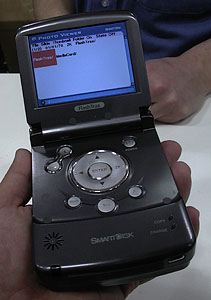 The firmware lets you zoom, pan and rotate images copied from your media. Any film can be copied. It can display JPEGs. Raw files are displayed using their built-in JPEG thumbnails. The firmware is upgradeable with user-installable software upgrades. It's a comfortable fit in the palm of your hand. And at only 12 oz., it's easy to carry. The 40-GB model can be found for $464 (list $699.99), about what the iPod/Belkin package costs but with a color display and some imaging functions. We were disappointed that Epson didn't bring their new $599, 10-GB P-1000 with its high-res 3.5" LCD to the show. But they aren't even sending out review units yet. However, both approaches suffer a significant flaw for the traveling photographer. They don't provide any way to make separate duplicate copies of your original files. Once you've copied an image to either device, you erase your card. So you only have one copy of the image. Even if you manage to create two copies, they are both on the same disk and device. We much prefer to travel with one of the $250 CD writers with card readers (like the recently reviewed RoadStor) that let you burn multiple CDs of your images. EXTERNAL DRIVES Not that we have anything against small external FireWire drives. We think you're nuts to compute these days without at least one to serve as a backup to your internal drive. So we're always looking for the latest, snazziest case design. And this year we drooled over the very slim, very light, aluminum Rocport 4. 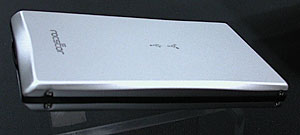 Available in capacities of 20, 30, 40 and 60-GB 4200 RPM drives and an 80-GB 5400 RPM drive, the device includes an Oxford 911 chip set for two 400-Mbps FireWire ports, a USB connector which supports USB 2.0 and a power switch. An optional power adapter is also available. Its 5x2.9x0.6 inches dimensions weigh only 6.4 oz. They even throw in a cable. La Cie came in a close second, though, with their Porsche-designed Mobile hard drives. Metal is in, apparently.  MACRO FLASH Which is bad news for flash photography. The only photographers who need more reflective subjects are the ones covering foreign affairs. But for macro photographers, Olympus showed its two new flash units designed for its dSLR, the E-1. 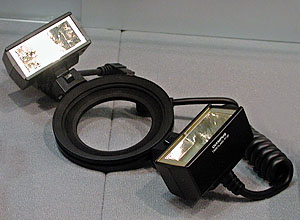 The $950 *STF-22 Twin Flash Set* delivers light from the sides rather than the front, revealing texture as well as detail. 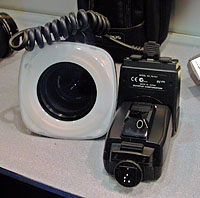 The $700 SRF-11 Ring Flash Set produces soft, even illumination, helpful for illuminating uneven surfaces. Both units can be attached to Olympus' 50mm f2.0 Zuiko Digital Macro lens with the optional FS-FR1 flash adapter ring. They can also be used on the Zuiko Digital 14-54mm and 50-200mm lenses via their 67mm threads. PRINTERS We got our first glimpse of Epson's new flagship printer, the Stylus Pro 4000. 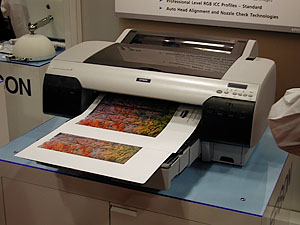 At $1,795 with 2880x1400-dpi resolution and variable droplets as small as 3.5 picoliters, it prints 1.9 times faster than previous Stylus Pros. The new one-inch wide printhead with 180 nozzles per channel can produce an 8x10 print in a minute and seven seconds. The same print at the finest quality level prints in seven minutes and eight seconds. 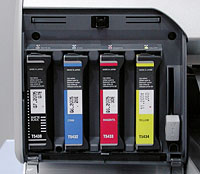 Using Epson UltraChrome pigment-based ink with seven colors (cyan, magenta, yellow, light cyan, light magenta, light black and one of two other unique black inks), print longevity is rated for 100 years on specific Epson papers under glass. There are two banks of cartridges at the front corners of the unit (the left bank is illustrated with the compartment door open). Media versatility has been one of the strengths of this line and the new 4000 is no exception. It can print 17x22-inch sheets and the built-in roll feeder and cutter add automated borderless printing to the mix. We also got a look at the $599 Olympus Camedia P-440. The 8x10 dye sub printer produces prints in five sizes up to a true 8x10 -- and in only 75 seconds. Postcard, photo album, index and A5 wide sizes are also available. 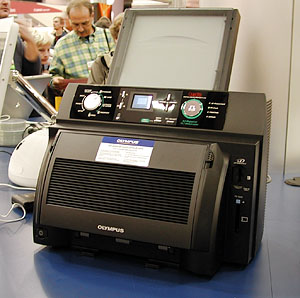 On the right side of the unit is a dual-slot card reader that can handle xD-Picture Cards in one slot and PCMCIA adapters in the other for CompactFlash, SmartMedia and Memory Stick cards. A 1.8-inch LCD provides preview, image selection and menus for the system so you can print without using a computer. The LCD output can also be directed to a television via a video cable. We were also enchanted with the output from the $229.95 Canon i960 Photo Printer, which can produce a 4x6 borderless print in 37 seconds and an 8x10 in about a minute. Using 3,072 nozzles to produce 4800x1200 dpi at 2 picoliter size, it can print directly from PictBridge-compatible digicams or via the USB 2.0 port.  The six individual ink tanks monitored by Canon's intelligent ink management system let you replace only the color that runs out. Hewlett-Packard was at the show displaying its line-up of printers including new color lasers. We find the halftoning process of laser printing more suited to document printing than photo printing. But we remain impressed with the Photosmart 7960 we reviewed recently. SCANNERS This was also our first chance to take a look at Nikon's new scanner line-up. The revamped line looks very good on paper and not too shabby in personal, either. They all scan at 4000-dpi resolution using Nikon ED (extra-low dispersion) glass and Nikon's LED light source. They also include Digital ICE Advanced image correction, which includes Digital ICE for image correction and enhancement, Digital ROC for color reconstruction of faded originals, Digital GEM for grain equalization to simulate lower-speed film and Digital DEE to enhance dynamic range. 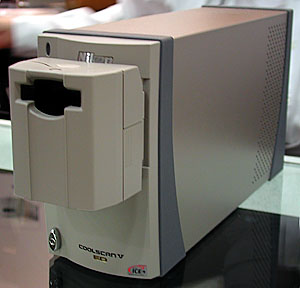 The $599.95 Coolscan V ED scans a 35mm slide or negative in 38 seconds using its 3964-pixel CCD to a 65-MB or 130-MB file (depending on whether you use 8- or 14-bit channels) with a dynamic range of 4.2. The original SA-21 Strip Film Adapter is shown in the illustration above. All the existing adapters are compatible with the new scanners. 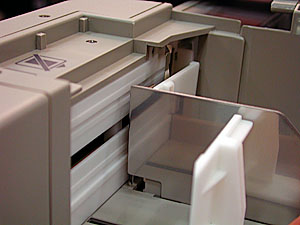 But Nikon also introduced one new adapter the SF-210 Slide Feeder (above), which features an adjustable mount thickness slot. The chrome guide actually slides closer or further from the white track. 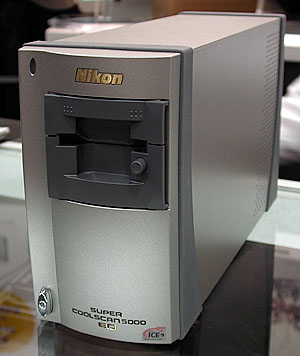 The $1,099.95 Coolscan 5000 ED does the job in 20 seconds using its 7928-pixel CCD with a dynamic range of 4.8. Like the V ED, it's a USB 2.0 device. And the $1,999.95 Coolscan 9000 ED is in a world of its own, with a 30,000-pixel CCD scanning 35mm formats as fast as 40 seconds and 6x9 formats in 185 seconds with a dynamic range of 4.8. It's a FireWire 400 device. Epson also introduced new scanners, two versions of the Perfection 4870. Both the Photo ($439 street) and Pro ($585 street) versions offer 4800x9600-dpi with Epson's Micro Step Drive technology, 3.8 Dmax and 16-bit channels, USB 2.0 and FireWire 400 interfaces and maximum document sizes of 8.5x11.7 for reflective material and 4x5 for transparencies. A 6x9 transparency unit is built into the top cover. 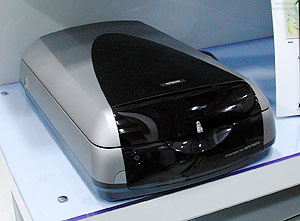 Software bundled with the 4870 Photo includes Epson Scan with Easy Photo Fix and Digital ICED, Photoshop Elements 2.0, LaserSoft SilverFast SE 6 and ABBYY FineReader Sprint OCR. The 4870 Pro adds ArcSoft PhotoStudio, PhotoBase and Panorama Maker, plus MonacoEZcolor 2.5 to that suite. CONCLUSION Touring the aisles at Macworld Expo, we felt a little like we had landed on another planet where every computer was running the latest operating system, every digicam was top of the line, each printer produced faultless prints and every scanner could handle the toughest transparency. We know the lay of the land is different in a production environment and even more so at home. But the revolution, as we noted in our Keynote coverage, is over. Digital photography has not only made it into our solar system. It's a practical -- even ideal -- way to capture and share images. After our tour of the aisles, we were anxiously looking for only one more thing. To get back to work using this stuff. |